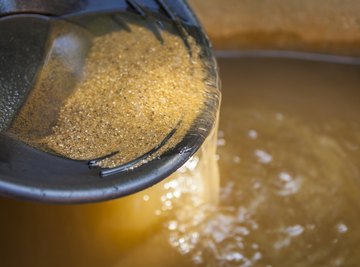
The narrative of the 1800s is punctuated by countless gold rushes that ignited imaginations and led to vast migrations. Gold fever was as contagious in the 19th century as scarlet fever. For some, the cure was striking it rich. For others, the gold fields yielded nothing but heartbreak. Starting in the mid-19th century, eight bonanzas sprang up on three different continents. A few of those are especially memorable for their economic and historical significance.
California Gold
In 1848, John Marshall discovered gold in what is now Coloma, California, while working for John Sutter on the American River. Once word got out, prospectors flooded the region in 1849, resulting in the largest migration of people the United States had ever seen.
Over $200 million dollars worth of gold was dug out of California's Sierra Nevada mountains between 1849 and 1852 - nearly $5.5 billion in modern dollars. When the surface was tapped out, mining companies gained the upper hand with the advent of hydraulic mining, a process that used river water to blast holes deep in the earth.
Those who failed to realize their individual dreams of striking it rich went to work for wages. Hydraulic mining continued to bring great wealth out of the ground, but wreaked havoc on the landscape and the rivers. It was outlawed in 1884, bringing an end to major mining operations in the region.
Pike's Peak or Bust!
Before becoming Colorado, the Pike's Peak region of the Kansas and Nebraska Territories was the scene of a short-lived gold rush lasting between 1858 and 1861. After William Russell and his two brothers found gold in creeks at the base of the Rocky Mountains, prospectors hurried to the region in covered wagons bearing "Pike's Peak or Bust!" signs in the hopes of another boom.
Though modest in overall earnings compared to the California Gold Rush, the creek named after that state alone produced $8 million worth of gold - over $200 million in today's currency. The rush panned out when placer gold - the nuggets and flakes found in streams and rivers - became scarce and the quartz ore extracted failed to produce any of the precious metal.
The Black Hills
The Black Hills Gold Rush began in South Dakota in 1874 after General George A. Custer led an expedition into the hills and found gold on French Creek. Though the Black Hills belonged to the Lakota Nation, the desire for gold was so intense that prospectors flooded the region, ignoring the requirement of the 1868 Treaty of Fort Laramie to seek Lakota permission first.
The boom, which gave rise to the city of Deadwood, produced the biggest gold mine in the United States - the Homestake Mine. It operated from 1876 to 2002 and dug up around 40 million ounces of gold, recognizable by distinctive shades of pink and green.
Witwatersrand
A deep gold mine stretching almost 250 miles was discovered in 1886 on a farm in the Transvaal region of South Africa. The area became a destination for thousands of prospectors from various countries who wanted a stake in the richest gold mine in the world. They settled a string of mining camps along a curve known as the Witwatersrand. Among them was one called Johannesburg - now the South African capital.
What previously had been an agricultural region became a wealthy producer of a third of the world's gold - 1.5 billion ounces. Mining continues in the region today.
The Klondike
Alaska was the last frontier for Americans in 1896 when George Carmack staked a claim where the Klondike river drained into a creek in the Yukon, part of Canada's Northwest Territories. By 1897, the first of hundreds of thousands of prospectors began the long, arduous journey to that remote area, enduring temperatures that sometimes fell below 50 degrees Fahrenheit.
Those who made it established Dawson City, which grew to a population of 30,000 in two years. Adjusted to modern currency, the Klondike produced over a billion dollars in gold. By 1900, no stakes were left to claim and those who arrived late had to go to work for others as the rush petered out.
Other Gold Rushes
The Great Australian Gold Rush began in New South Wales in 1851. For the next 50 years, gold discoveries continued to spring up across the continent, in places such as New South Wales, Victoria, Coolgardie and Queensland, bringing economic booms and vast population growth.
In New Zealand, the Central Otago Gold Rush was ignited when the provincial government offered a large monetary reward to anyone who found gold in the area. The South American archipelago, Tierra del Fuego, was also the site of a gold rush in the late 1800s after Chilean Ramón Serrano Montaner found gold there. The rush lasted into the early 20th century.
References
Resources
About the Author
Karen Clark has been writing professionally since 2001. Her work includes articles on gardening, education and literature. Clark has also published short literary fiction in the "Southern Humanities Review" and has co-authored a novel. Her professional experience includes teaching and tutoring students of all ages in literature, history and writing. She holds a Bachelor of the Arts in political science and a Master of Fine Arts in writing.
